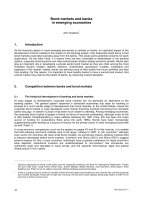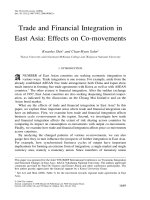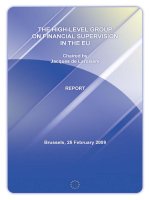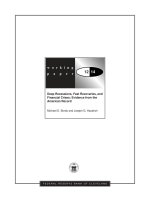ffrench-davis (ed.) - financial crises in successful emerging economies (2001)
Bạn đang xem bản rút gọn của tài liệu. Xem và tải ngay bản đầy đủ của tài liệu tại đây (1 MB, 184 trang )
Financial Crises in
“Successful” Emerging
Economies
Ricardo Ffrench-Davis,
Editor
UNITED NATIONS
BROOKINGS INSTITUTION PRESS
Financial Crises
in “Successful”
Emerging Economies
This page intentionally left blank
Financial Crises
in “Successful”
Emerging
Economies
Ricardo Ffrench-Davis
editor
UNITED NATIONS
Economic Commission for Latin America
and the Caribbean
BROOKINGS INSTITUTION PRESS
Washington, D.C.
The Brookings Institution is a private nonprofit organization devoted to
research, education, and publication on important issues of domestic and foreign policy.
Its principal purpose is to bring knowledge to bear on current and emerging policy
problems. The Institution maintains a position of neutrality on issues of public
policy. Interpretations or conclusions in Brookings publications should be
understood to be solely those of the authors.
Copyright © 2001
All rights reserved. No part of this publication may be reproduced or transmitted in any
means without written permission from the Brookings Institution Press.
Financial Crises in “Successful” Emerging Economies may be ordered from:
, 1775 Massachusetts Avenue, N.W.,
Washington, D.C. 20036. Telephone: 800/275-1447 or 202/797-6258.
Fax: 202/797-6004. Internet: www.brookings.edu.
Library of Congress Cataloging-in-Publication data
Financial crises in “successful” emerging economies / Ricardo
Ffrench-Davis, editor.
p. cm.
Includes bibliographical references and index.
ISBN 0-8157-0211-6 (pbk. : alk. paper)
1. Latin America—Economic conditions. 2. Asia—Economic
conditions. 3. Financial crises—Latin America. 4. Financial crises—Asia.
I. Ffrench—Davis, Ricardo. II. United Nations. Economic Commission for
Latin America and the Caribbean.
HC123 .F56 2001 2001003366
332’.095—dc21
9 8 7 6 5 4 3 2 1
The paper used in this publication meets minimum requirements of the
American National Standard for Information Sciences—Permanence of Paper for
Printed Library Materials: ANSI Z39.48-1992.
Typeset in Adobe Garamond
Composition by Northeastern Graphic Services, Hackensack, New Jersey
Printed by R. R. Donnelley and Sons, Harrisonburg, Virginia
Preface vii
1 The Globalization of Financial Volatility: Challenges
for Emerging Economies
1
-
2 Korea and Taiwan in the Financial Crisis 38
.
3 Three Varieties of Capital Surge Management in Chile
65
-
4 From the Capital Surge to the Financial Crisis and
Beyond: The Mexican Economy in the 1990s
107
5 An International Financial Architecture for
Crisis Prevention
141
-
Contributors
167
Index 169
Contents
v
This page intentionally left blank
T
his book is the result of a project developed by the
United Nations Economic Commission for Latin
America and the Caribbean (ECLAC), with support from the Ford Foun-
dation. The text encompasses five articles analyzing emerging economies
that were generally rated as successful by international financial institu-
tions and the financial press during episodes characterized by a broad sup-
ply of external funds. We include the cases of Chile, Korea, and Mexico in
the critical years of the 1990s and Chile in the deep crisis of the 1970s. All
of these economies were praised for their efficient public policies. They
all experienced episodes of an abundant supply of financial capital, and
they all suffered macroeconomic disequilibria as a result. We contrast these
cases with the positive experiences of Chile during the Tequila crisis and
of Taiwan during the Asian crisis.
Three of the articles are country studies, undertaken from a compara-
tive perspective. The paper by Manuel Agosin, professor at the University
of Chile, draws parallels between Korea and Taiwan. These two countries
achieved a similar performance from the mid-1960s through the early
1990s, but their paths then diverged. The study analyzes the national poli-
cies adopted in each case and the underlying motives.
The article by Ricardo Ffrench-Davis and Heriberto Tapia, both econ-
omists at ECLAC, compares three positive financial shocks experienced in
Chile: the liberalization of the capital account in the 1970s, which exploded
in a massive crisis in 1982; a substantial policy shift in 1991–94 in the di-
rection of a prudential macroeconomic management of the capital account,
Preface
vii
which kept Chile immune to the tequila crisis in 1995; and the capital surge
of 1995–97, which culminated in a rather severe adjustment in 1999.
The third study is by Dr. Jaime Ros, Mexican economist and profes-
sor at Notre Dame University, who addresses the contrasting experiences
of Mexico in 1991–94 and 1996–97. The paper examines the different do-
mestic and external variables that explain the marked differences in the
two episodes, and it evaluates the depth of the economic and social effects.
The fourth article, by Dr. Stephany Griffith-Jones of the University of
Sussex, analyzes the current architecture of the international financial sys-
tem and its incapacity for preventing crises or moderating the disequilibria
that generally lead to crises. The article analyzes several recent proposals, in-
cluding those of the author herself.
Finally, the paper by José Antonio Ocampo, Executive Secretary of
ECLAC, and Ricardo Ffrench-Davis, which opens the book, examines
why countries that were considered successful before the explosion of a cri-
sis incurred a level of macroeconomic disequilibria that made them vul-
nerable to a financial run. We start by considering the nature of supply,
focusing on investors who specialize in short-term, highly liquid opera-
tions. We then trace the evolution of the prices of financial assets, foreign
exchange, and stock markets in the receiving countries, and we identify
links with paths that culminate in unsustainable macroeconomic disequi-
libria. On the basis of this analysis, we expose five misconceptions that are
commonly held among proponents of full liberalization of the capital ac-
count.
Heriberto Tapia provided highly professional support in preparing the
final manuscript, verifying the technical content, and ensuring agreement
between the Spanish and English versions. Lenka Arriagada was excep-
tionally efficient in assisting with the presentation of the final manuscript.
We thank ECLAC for providing a stimulating environment for
policy-oriented research and the opportunity for independent analysis on
a most relevant issue today. Our deepest thanks also go to the Ford Foun-
dation for its support. Naturally, all the opinions presented here are the re-
sponsibility of the respective authors.
viii
Financial Crises
in “Successful”
Emerging Economies
This page intentionally left blank
1
O
ne of the outstanding features of modern financial
crises is that they occurred in emerging economies
that were generally viewed as very successful until the crises exploded.
Moreover, recent crises have been radically different from those typical
from the 1940s to the 1970s, which, in Latin America, displayed three
major features that have been absent or relatively less important in recent
experiences. First, past crises involved large fiscal deficits that were fi-
nanced with external loans or, in the absence of such financing, by central
banks. Second, domestic financial systems were repressed, a fact that was
generally accompanied by private sector access to rediscount or bank loans
at negative real interest rates. Finally, balance of payments crises were fre-
quently associated with a sharp worsening in the terms of trade or explicit
domestic policy decisions to overvalue exchange rates.
Over the past quarter century, a new variety of crises has gradually de-
veloped in Asia and Latin America. Four features differentiate them from
the previous type. First, the international capital market has been the major
source of shocks, whether positive or negative. Second, flows have largely
originated from and been received by the private sector. Fiscal deficits, in
contrast, have played a secondary role, and in most cases public finances
have been sound. Third, these financial crises have mostly hit emerging
-
*
The Globalization of
Financial Volatility:
Challenges for Emerging
Economies
*We appreciate the assistance of Angela Parra and Heriberto Tapia.
-
economies that were considered to be highly credible and successful. In
fact, the bulk of private flows has been concentrated on a small number of
relatively affluent and well-organized developing nations. Fourth, these
flows have been characterized by a lack of regulation, on both the supply
and demand sides. Domestic financial systems have often been liberalized
without the parallel development of a significant degree of domestic pru-
dential regulation and supervision.
In practice, the differentiation between old- and new-style crises is
naturally somewhat less clear-cut than the above description would sug-
gest. An early example of the new variety was the Chilean experience of
the 1970s and early 1980s, but the old type of crisis was still prevalent in
the rest of Latin America during that period, with other Southern Cone
countries in an intermediate position. In the 1990s, the new type gener-
ally predominated in both Latin America and Asia, but there were some
mixed episodes in which features of both new and old crises were inter-
mingled, with budget deficits and terms-of-trade fluctuations.
The evolution of private capital flows over the past three decades is well
known. During the 1970s, a large supply of funds was made available to
many developing nations. The 1980s brought a severe and widespread
shortage of financing, particularly for the Latin American countries. In
contrast, the Asian countries that were affected by the disturbances in the
international financial markets adjusted rapidly (with the exception of the
Philippines) and were able to leave the contagion effects behind. External
financing returned to Latin America in the 1990s, but it was volatile. The
resurgence of capital flows between 1991 and 1994 was followed by a sharp
scarcity, especially in Mexico and Argentina, with a rather generalized port-
folio outflow in late 1994 and early 1995. The so-called tequila crisis gave
way to renewed access in 1996–97, but in 1998–2000 external financing
was again in short supply as a result of contagion from the crisis detonated
in Asia in 1997. Worsening terms of trade aggravated the recession. On all
those occasions, changes in external financing were supply-led.
1
They had
a strong impact on the national economies on both sides of the cycle, with
contagion first of overoptimism and then of overpessimism.
Through 1996, the successful emerging economies of Asia appeared
to be immune to the instability associated with capital surges, as illustrated
by their performance during the tequila crisis. In reality, part of the out-
flows from Latin American countries were reallocated to Asia during that
1. Evidence shows that these changes have originated, to a large extent, in the sources of supply. See
Calvo (1998); Culpeper (1995); Griffith-Jones (1998); Larraín (2000).
episode. The subsequent events show that immunity was no longer a fea-
ture of the East Asian economies, and the two regions now faced common
destabilizing external forces.
The following section outlines the three capital surges experienced by
Latin American countries since the 1970s. Subsequently, the paper reviews
the main macroeconomic effects generated by capital surges and their pol-
icy implications. We then compare the specific experiences of the emerg-
ing economies covered by this research project: Korea and Mexico in the
1990s and Chile in the 1970s were all regarded as highly successful until
the sudden outbreak of severe crises. The study contrasts these experiences
with Chile in the early 1990s and Taiwan throughout the last decade,
which provide examples of economies that deployed a set of prudential
macroeconomic policies and thereby avoided domestic disequilibria and
mitigated contagion. The paper then addresses five misconceptions that
are currently in fashion. The final section summarizes some robust lessons
for domestic policies and reform of the international financial architecture.
Three Financial Capital Surges to Emerging Economies
since the 1970s
Purely financial factors have been changing in the world at a much
faster pace than international trade and the globalization of production.
During the 1970s and 1980s, many countries began to liberalize their fi-
nancial sectors and to relax or eliminate foreign exchange regulations.
2
This contributed to a boom in international flows, which was facilitated
by the revolutionary innovations in data management and telecommuni-
cations technology and the emergence of increasingly sophisticated finan-
cial techniques. The financial booms generally occurred within a
framework of lax or nonexistent regulations and supervision, and most ex-
isting regulations were in fact procyclical.
3
Net capital inflows to Latin America averaged nearly 5 percent of gross
domestic product (GDP) in 1977–81, 1991–94, and 1996–97. Exchange
rates appreciated in all three periods, which naturally led to a rapid in-
crease of imports relative to exports, with the corresponding current ac-
count deficit being financed (indeed, overfinanced) by a sharp rise in the
2. Díaz-Alejandro (1985); Devlin (1989).
3. Ocampo (1999, 2001); Griffith-Jones (in this volume); United Nations (1999); Turner (2000).
-
stock of external liabilities.
4
All these macroeconomic variables experi-
enced some overshooting.
5
Adjustment was frequently anchored to one
dominant balance, which generated imbalances in other macroeconomic
variables, as in a falling inflation rate associated with real exchange rate ap-
preciation and climbing external deficits. Such adjustment was obviously
facilitated by access to external financing, which most probably would
have been absent in a dry foreign supply.
The increased supply of external funding in those three episodes gener-
ated a greater demand for such financing. Recipient countries that adopted
procyclical or passive domestic policies experienced real exchange revalua-
tion and large current account deficits. Because these were heavily financed
by volatile flows of mostly short-term, liquid capital, the economies tended
to become increasingly vulnerable to changes in the mood of external cred-
itors; the outstanding case was Mexico in 1991–94 (see Ros, in this volume).
Creditors with financial assets placed in the region became more sensitive to
bad news as their exposure increased. The sensitivity rose steeply with the
size of net short-term liabilities.
6
The dramatic increase of international financial flows was more diver-
sified in the 1990s than in the 1970s. The situation is potentially more un-
stable, however, inasmuch as the trend has shifted from long-term bank
credit, which was the predominant source of financing in the 1970s, to
portfolio flows; medium- and short-term bank financing; time deposits;
and foreign direct investment (FDI; including acquisitions and other than
greenfield investment). A very high share of the newer supply of financing is
short term or liquid or both. The region thus saw a paradoxical diversifica-
tion toward volatility in the 1990s. The relative improvement after the te-
quila crisis, with a rising share of FDI, still included a significant proportion
of volatile flows.
7
The foundations of a broad liquid market for portfolio in-
vestment were laid down in the late 1980s through the Brady bonds and de-
veloped vigorously in the 1990s, with Latin America as a major destination
for both bond and stock financing. This market offered the expectation of
high rates of return during the upswings of the two cycles in the 1990s.
4. ECLAC (1995, 1998, 2000a).
5. When significant macroeconomic disequilibria persists despite repeated statements on the need
to maintain equilibria, it reveals an inadequate understanding of how to achieve sustainable equilib-
ria that are consistent with development. See Ffrench-Davis (2000, ch. 6).
6. Rodrik and Velasco (1999).
7. The positive link between FDI and productive investment is well documented (see Ffrench-Davis
and Reisen, 1998, chap. 1). The link was weakened, however, by the fact that about 40 percent of FDI
inflows in 1997–99 corresponded to acquisitions of Latin American firms rather than the creation of
new capacity (ECLAC, 2000b, chap. 1).
In 1991 the stock of assets invested in Latin America by the new in-
vestors that had discovered the emerging markets was evidently below their
desired stock level, but by 1994 it had become considerably larger. Net
capital inflows were used to finance rising current account deficits, and ex-
ternal liabilities accumulated through time. This was sometimes accompa-
nied by significant mismatches in the maturity structure of the balance
sheets of domestic financial intermediaries, when short-term external
funds were used to finance longer-term domestic credits. This issue was
particularly severe in the dollarized segment of the domestic financial sys-
tem and in those cases in which external interbank credit lines were used
as a major source of domestic financing. Consequently, the region moved
into a vulnerability zone, with the economy becoming increasingly sensi-
tive to adverse political or economic news and “hostage to the whims and
fancies of a few country analysts in London, Frankfurt and New York.”
8
This situation was likely to “put the economy at the mercy of the capital
markets’ occasionally whimsical moods.”
9
The longer and deeper the econ-
omy’s incursion into that zone, the more severe was the financierist trap in
which authorities could get caught, and the lower the probability of leav-
ing it without undergoing a crisis.
10
Mexico and Argentina were particularly vulnerable in 1994, while
Chile had deliberately avoided venturing into the vulnerability zone.
Meanwhile, East and Southeast Asian countries were just starting to take
that risk in the first half of the 1990s, and the resulting mismatches in the
maturity structure of the balance sheets of domestic financial intermedi-
aries proved to be even more severe than a worsening net debt position.
By the next cycle, several economies in both Asia and Latin America had
penetrated deep into the vulnerability zone. Both regions suffered severe
crises when the mood of the external market changed.
Worsening of Macroeconomic Fundamentals Led by Inflows
The economic activity of Latin American countries exhibited signifi-
cant vulnerability to changes in international financial markets over the
last three decades, which worked as an intensely procyclical factor for the
8. Rodrik (1998).
9. Calvo (1998).
10. The financierist trap refers to a macroeconomic policy approach that leads to an extreme pre-
dominance of or dependency on agents specializing in microfinance, positioned in the short-term and
liquid segments of the market.
emerging economies. This vulnerability was associated with the volatility
of international markets since the 1970s, as well as with the procyclical
macroeconomic policies adopted by recipient countries. Several Asian
emerging economies followed suit in the 1990s.
Annual GDP growth rose in Latin American countries from 1.3 per-
cent in the 1980s to 4.1 percent between 1991 and 1994 and 4.5 percent
in 1996 and 1997. Recessive adjustments took place in 1995 and 1998–99
(see table 1-1). Overall, GDP rose by a mere 3.3 percent in the decade
(1991–2000). Given that GDP was highly unstable, however, the precise
figure depends on the period chosen. For 1990–99 the growth rate was 2.8
percent, because the period starts and ends with a recession. From peak to
peak (between 1989 and 2000), average growth was 2.9 percent.
A growth of productive capacity of around 3 percent (1.3 percent per
capita) is remarkably low compared with the expectations generated by the
structural reforms. Comparison with the previous golden age is striking.
During the three decades from 1950 and 1980, GDP growth averaged 5.5
percent a year (2.7 percent per capita), with rather high domestic invest-
ment ratios sustaining these vigorous rates. In the 1980s, gross domestic
investment dropped sharply, by 7 percentage points of GDP. The recovery
in the 1990s was weak (see figure 1-1). In fact, investment grew much less
during this decade than did capital inflows; a significant proportion of ex-
ternal flows thus financed increased consumption, crowding out domestic
savings.
11
Recovery from Recession
The domestic conjuncture has crucial implications for the link be-
tween capital flows and economic activity. When there is a binding exter-
nal constraint, any inflow will contribute to relaxing it, thus facilitating a
recovery of economic activity. Binding external constraints predominated
during several episodes in many Latin American countries, and they were
particularly widespread from the early 1980s up to 1990, in 1995 and in
1998–2000.
In the early 1990s, renewed capital inflows thus contributed to a recov-
ery of economic activity, and they facilitated the adoption of successful
anti-inflationary adjustments. Argentina and Peru, for example, both fea-
tured huge underutilization of capacity and hyperinflation; the disappear-
-
11. See Ffrench-Davis (2000, chap. 1 and 5); Uthoff and Titelman (1998).
Table 1-1. Latin America and East Asia: Gross Domestic Product, 1971–2000
Annual growth rate (percent)
Region and
country 1971–80 1981–89 1990 1991–94 1995 1996–97 1998–99 1991–2000
Latin America
(19 countries)
a
5.6 1.3 -0.6 4.1 1.1 4.5 1.2 3.3
Argentina 2.8 -0.7 -2.0 8.0 -2.9 6.7 0.4 4.2
Brazil 8.6 2.3 -4.6 2.8 4.2 3.0 0.5 2.7
Chile 2.5 3.0 3.3 7.5 9.1 6.9 1.5 6.1
Colombia 5.4 3.7 4.3 4.3 5.2 2.8 -2.1 2.6
Mexico 6.7 1.5 5.1 3.5 -6.1 6.1 4.3 3.5
Peru 3.9 -0.7 -6.0 5.1 8.6 5.4 1.0 4.5
Venezuela 1.8 -1.5 5.5 3.2 -1.9 3.4 -3.6 2.1
1971–80 1981–90 1991–92 1993–96 1997 1998 1999 1991–2000
East Asia
(6 countries)
b
8.1 7.0 7.3 7.3 4.8 -4.2 6.5 5.6
Indonesia 7.7 5.5 8.1 7.7 4.7 -13.2 0.2 4.2
Korea 9.0 8.8 7.3 7.3 5.0 -6.7 10.7 6.1
Malaysia 7.8 5.2 9.2 9.7 7.5 -7.5 5.4 7.1
Philippines 5.9 1.7 -0.1 4.2 5.2 -0.6 3.3 2.8
Taiwan 9.3 8.5 7.5 6.7 6.7 4.6 5.7 6.5
Thailand 7.9 7.9 8.3 8.0 -1.7 -10.2 4.2 4.5
Source: For Latin America, the United Nations Economic Commission for Latin America and the Caribbean (ECLAC). For East Asia, the International
Monetary Fund (IMF), International Financial Statistics, November 2000; Asian Development Bank; J.P. Morgan.
a. National accounts expressed in U.S. dollars at 1980 prices for 1971–80, at 1990 prices for 1981–89, and at 1995 prices for 1990–2000.
b. In each period, each country’s GDP was weighted by its average share in the regional output, expressed in current dollars.
-
Figure 1-1. Latin America: Gross Fixed Investment, 1977–2000
Source: Author’s calculations, based on ECLAC figures, scaled to constant 1995 prices.
26
24
22
20
18
0
Percent of GDP
1977 1978 1979 1980 1981 1982 1983 1984 1985 1986 1987 1988 1989 1990 1991 1992 1993 1994 1995 1996 1997 1998 1999 2000
25.9
23.7
19.2
19.8
ance of the binding external constraint and the reintroduction of macroec-
onomic discipline to combat hyperinflation were strongly complementary.
The monetary effects of reserve accumulation and the wealth effects of ex-
change rate appreciation tended to push up aggregate demand, which facil-
itated the recovery of economic activity. At the other end of the spectrum,
capacity underutilization was not significant in Chile and Mexico. Conse-
quently, the positive link between capital flows and GDP growth was not
automatic, but rather was contingent on the capacity to transform addi-
tional external financing into increased productive investment.
On average, Latin American GDP rose faster in 1991–94 than the ex-
pansion of the production frontier thanks to increased capacity utilization.
An estimated one-third of the 4.1 percent annual GDP growth in
1991–94 was based on this factor. In 1995, the binding external constraint
again became a crucial variable, with GDP growth lagging behind capac-
ity growth. Renewed capital inflows in the following years contributed to
a recovery of economic activity, based to some extent on the excess capac-
ity generated in 1995. However, the return of a binding external constraint
in 1998–99, particularly in South America, led to a new recession.
One implication of this analysis is that any serious research should
control for the huge swings in the rate of capacity utilization when meas-
uring productivity and the performance of policies and reforms. In the
presence of excess capacity, recovery naturally yields high private and so-
cial returns, but they are built on preexisting disequilibria, that is, on for-
gone profits, wages, taxes, and employment that exist whenever the
economy is operating below its productive frontier or economically poten-
tial GDP. Whether economic recovery opens the way to more sustained
growth depends crucially on two dimensions. First, the speed at which ca-
pacity is expanded—through physical investment, investment in people,
and productivity gains—determines future potential growth. Second, the
sustainability of the macroeconomic environment that develops during
the recovery—namely, exchange and interest rates, current account defi-
cit, domestic financial vulnerability, fiscal accounts, and asset prices—de-
termines whether growth in aggregate demand can be sustained or
whether it will be subject to corrections associated with imbalances accu-
mulated during recovery.
Overshooting in Emerging Asia and Latin America
The increased availability of financing in the 1990s removed the bind-
ing external constraint that had been responsible for the decade-long re-
cession in Latin America. The bases for growth were not laid down,
however, as investment did not increase rapidly and macroeconomic im-
balances built up. Effective output thus approached the production fron-
tier, while exchange rate appreciation led to overvaluation.
12
Asset markets
also overshot, and a large stock of mostly liquid external liabilities accu-
mulated (see figure 1-2). The region’s economies therefore became more
vulnerable to future negative external shocks. With some variation, this
story applies to both 1991–94 and 1995–97, reproducing the path toward
the crisis of 1976–81.
In 1995, the tequila crisis had negligible effects on the Asian region,
even in economies with large current account deficits, such as Malaysia
and Thailand. Many outstanding researchers and observers therefore as-
serted in 1996 that such deficits were not relevant if investment ratios and
economic growth were high. Several Asian countries had successfully reg-
ulated capital inflows and foreign exchange markets for long periods.
13
Ec-
onomic growth was actually sustained and extremely high. From 1970 to
12. Several Latin American countries implemented sharp import liberalization at the same time that
the exchange rate was appreciating. See Ffrench-Davis (2000, chap. 3) and ECLAC (1998, chap. 5;
for an English version, see ECLAC 1995). The average import tariff was cut from 45 percent in the
mid-1980s to 13 percent in the mid-1990s; nontariff restrictions were also reduced significantly.
13. On Malaysia, Indonesia, and Thailand, see Sachs, Tornell and Velasco (1996); on Korea and
Taiwan, see Agosin (in this volume).
-
Figure 1-2. Latin America and East Asia: Current Account Balance,
1990–2000
a
Source: ECLAC; IMF.
a. East Asia includes Indonesia, Korea, Malaysia, the Philippines, and Thailand. Latin America includes nineteen
countries.
10
8
6
4
2
0
–2
–4
Percent of GDP
1990
1991 1992 1993 1994 1995 1996 1997 1998 1999 2000
Surplus
Deficit
East Asia
Latin America
1996, yearly GDP growth averaged 8 percent in Korea, Indonesia, Malay-
sia, Taiwan, and Thailand (see table 1-1 above). The investment ratio fre-
quently exceeded 33 percent, with domestic savings ratios at a similar level.
Inflation was low (in the range of 5 percent a year), and fiscal budgets were
generally balanced or in surplus (with the exception of Taiwan). Mean-
while, average GDP growth in Latin America was 2 percent and the in-
vestment ratio fluctuated around 20 percent.
What is the explanation for the sudden worsening in Asia? First, export
performance in several Asian economies weakened. Export sectors that had
been experiencing notably dynamic demand suddenly faced tightening
markets, either as a result of a temporary excess supply or because specific
markets were reaching maturity.
14
The long Japanese crisis contributed to
the intensity of these problems.
Second, the global drive toward financial liberalization had also per-
meated several Asian economies in the 1990s.
15
China, India, and Taiwan
were three notable exceptions. Capital inflows and current account deficits
increased substantially in Korea and Thailand from 1993 on. External im-
14. Radelet and Sachs (1998).
15. Agosin (in this volume); Ariff and Ean (2000); Akyüz (1998); Furman and Stiglitz (1998); Jomo
(1998); Wang (2000).
balances were not associated with public deficits and did not imply losses of
international reserves: in fact, in Korea, Indonesia, Malaysia, and Thailand,
international reserves, fed by capital inflows, accumulated consistently be-
tween 1992 and early 1997, more than doubling in the period. All the data
indicate that the cause of disequilibria was a rise in private expenditure led
by capital inflows, which allowed liquidity constraints to be relaxed. The
induced domestic lending boom was accompanied by bubbles in real estate
and stock market prices. In some cases, real exchange rate appreciation and
import liberalization led to cheaper imports, which further fed the import
boom.
Third, most inflows were short term or liquid, including a large pro-
portion of interbank lending.
16
Domestic balance sheets became quite vul-
nerable as a result of maturity and currency mismatches and the rapid rise
of firms’ leverage.
17
Weak prudential supervision of the financial system,
which had not been a real threat in the previously repressed domestic mar-
kets, became evident with financial liberalization and the lending boom.
In these Asian economies, vulnerability was thus associated with wors-
ening macroeconomic fundamentals led by a capital surge, which carried
over to an exchange rate appreciation (moderate compared to that in Latin
America), a boom in aggregate private demand (with a significant enlarge-
ment of the current account deficit by 5 percentage points of GDP in
Korea, 2 points in Indonesia, and 3 points in Thailand), and an increased
vulnerability of the balance sheets of domestic financial intermediaries.
The disequilibrium was recognized by financial markets only in 1997 and
resulted in a weighty bill in 1998. The policy failure was an error shared
with the rather similar financial reforms conducted in Chile in the 1970s
and in Mexico in the 1990s.
18
Why the Market Fails to Avoid Overshooting
On the whole, the authorities took a procyclical approach in both
Latin America and Asia, allowing capital surges to be transmitted domesti-
cally. They therefore fell into a financierist trap, from which it is extremely
difficult to escape without a traumatic adjustment, involving outlier ex-
change or interest rates and considerable liquidity constraints that together
generate a very unfriendly macroeconomic environment for firms and
16. IMF (1998); Radelet and Sachs (1998).
17. See Krugman (1999).
18. Ffrench-Davis and Tapia (in this volume); Ros (in this volume).
labor. Most authorities (as well as observers) took the view that nothing
could or should be done during the expansive stages, or they preferred to
benefit a little longer from the capital boom. The ex post consensus among
observers, however, was that disequilibria had accumulated.
Given that voluntary flows cannot take place without the willing con-
sent of both debtors and creditors, why did neither agent act in due time
to curb the inflows well before a crisis? Some specialists recognized and
warned of the growing vulnerability in all three episodes examined. Why,
then, did the market fail to avoid major crises?
19
Asymmetries of informa-
tion among creditors, lack of adequate internalization of the negative ex-
ternalities that each agent generates (through growing vulnerability), and
other imperfections of international capital underlie the cycles of abun-
dance and shortage of external financing.
20
These factors contribute to
herd behavior, cross-border contagion, and multiple equilibria.
Over and above these features, however, the particular nature of the
agents acting on the creditor side is crucially important. Short-term hori-
zons were a significant factor in the 1990s, as reflected in the volatility of
flows that characterized the boom-bust cycles. The gradual spread of in-
formation on investment opportunities is another key influence. Investors
from different segments of the financial market were steadily drawn into
international markets as they took notice of the profitable opportunities
offered by emerging economies. This explains why the three surges of
flows to emerging economies were processes that went on for several years,
rather than one-shot changes in supply.
On the domestic side, many Latin American economies were experi-
encing recession, depressed stock and real estate markets, high interest rates,
and initially undervalued exchange rates; capital surges directed to these
economies therefore could expect potentially high rates of return.
21
Indeed,
in the early 1990s, prices of equity stocks and real estate were extremely
depressed in Latin America. That allowed for a 300 percent average capital
gain in the Latin American stock markets between late 1990 and September
1994, with rapidly rising price-to-earnings ratios (see table 1-2).
22
Average
-
19. For instance, see a warning advice on Latin America, as early as in mid-1992, reproduced in
Ffrench-Davis (2000, chap. 9).
20. McKinnon (1991); Rodrik (1998); Stiglitz (2000); Wyplosz (1998).
21. A similar outcome tends to result in an emerging economy moving from a closed to an open
capital account. The rate of return is naturally higher in the productive sectors of capital-scarce emerg-
ing economies than in mature markets that are capital rich.
22. Figures in current dollars; the real rate of return is obtained by adding distributed profits and
subtracting dollar inflation.
Table 1-2. Latin America and East Asia: Stock Exchange Prices, 1990–2000
a
Indexes (July 1997 = 100)
Region and
country Dec 1990 Sep 1992 Sep 1994 Mar 1995 July 1997 Aug 1998 Dec 1999 Nov 2000
Latin America
(7 countries) 21.7 44.6 92.5 52.3 100.0 47.2 84.0 67.9
Argentina 13.4 46.9 78.2 53.5 100.0 53.4 86.7 64.6
Brazil 8.0 22.1 71.8 42.8 100.0 44.4 73.5 61.0
Chile 24.5 51.4 93.1 89.4 100.0 48.0 75.3 64.6
Colombia 16.6 65.0 113.1 96.3 100.0 49.9 44.9 26.0
Mexico 38.6 72.7 132.1 45.9 100.0 49.7 110.8 93.0
Peru n.a. n.a. 72.9 56.4 100.0 57.3 66.0 47.7
Venezuela 84.9 82.2 50.8 37.9 100.0 26.2 37.4 44.7
East Asia
(6 countries) n.a. 49.9 110.0 97.9 100.0 37.0 101.6 59.5
Indonesia n.a. 53.7 84.2 71.6 100.0 11.1 37.0 15.8
Korea n.a. 87.6 187.2 161.9 100.0 30.2 135.5 62.9
Malaysia n.a. 63.7 119.0 103.5 100.0 16.8 49.9 42.1
Philippines n.a. 67.1 134.6 108.6 100.0 30.4 61.0 32.9
Taiwan n.a. 37.1 80.9 73.5 100.0 47.6 84.1 50.0
Thailand n.a. 133.9 279.8 236.3 100.0 19.0 59.1 27.5
Source: Authors’ calculations, based on data from the International Financial Corporation and Standard & Poor’s, Emerging Stock Market Review, several
issues.
a. The averages for Latin America and East Asia are weighted by amount of transactions. Values correspond to the end of each period, expressed in current
dollars, excluding distributed earnings. Selected dates correspond to peaks and minimum levels for the Latin American average.
prices dropped sharply around the time of the tequila crisis, which produced
contagion to all Latin American stock markets, and then nearly doubled
between March 1995 and June 1997, pushed up directly by portfolio in-
flows.
Domestic interest rates tended to be high at the outset of surge epi-
sodes, reflecting the binding external constraint faced by most countries
during periods of sharp reductions in capital inflows, the restrictive mon-
etary policies then in place, and the short-term bias of the financial re-
forms implemented in Latin America.
23
Finally, the increased supply of
external financing generated a process of exchange rate appreciation in
most Latin American countries (see table 1-3). This encouraged additional
inflows from dealers operating with maturity horizons within the expected
appreciation of the domestic currency.
The interaction between the two sets of factors—the nature of inves-
tors and the adjustment process—explains the dynamics of capital flows
over time. When creditors discover an emerging market, their initial expo-
sure is nonexistent. They then generate a series of consecutive flows, which
result in rapidly increasing stocks of financial assets in the emerging mar-
ket. The creditor’s sensitivity to negative news, at some point, is likely to
suddenly increase remarkably with the stock of assets held in a country (or
region) and with the debtor’s degree of dependence on additional flows,
which is associated with the magnitude of the current account deficit, the
refinancing of maturing liabilities, and the amount of liquid liabilities
likely to flow out of the country in the face of a crisis. The probability of
a reversal of expectations about future trends therefore grows steeply after
a significant increase in asset prices and exchange rates accompanied by ris-
ing stocks of external liabilities.
The accumulation of stocks and a subsequent reversal of flows can
both be considered to be rational responses on the part of individual sup-
pliers, given the short-term horizon of the principal agents on the supply
side. Investors with short horizons are little concerned with whether cap-
ital surges improve or worsen long-term fundamentals while they continue
to bring inflows. What is relevant to these investors is whether the crucial
indicators from their point of view—exchange rates and real estate, bond,
and stock prices—can continue providing them with profits in the near
term and, obviously, that liquid markets allow them to quickly reverse
decisions. They will continue pouring money in until expectations of an
-
23. See Ffrench-Davis (2000, chap. 2).









